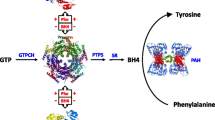Summary
Deficiency of dihydropteridine reductase causes a variant form of phenylketonuria associated with a devastating neurological disease characterized by mental retardation, hypokinesis and other features relating to basal ganglia disorder. Hyperphenylalaninaemias with tetrahydrobiopterin deficiency make up about 1–3% of all hyperphenylalaninaemias. We describe three patients from Calabria, a southern region of Italy, who have a dihydropteridine reductase deficiency, caused by the same mutation (p.L14P) also found in the nearby region of Sicily. We report the evolution of clinical and biochemical data during the treatment of these patients where we used prolactin serum determination to adapt the specific therapy. This report suggests that serum prolactin levels can be a good biomarker for optimal dosage of hydroxylated precursors in long-term treatment monitoring.

Similar content being viewed by others
Abbreviations
- BH4 :
-
tetrahydrobiopterin
- CSF:
-
cerebrospinal fluid
- DHPR:
-
dihydropteridine reductase
- DQ:
-
development quotient
- DQPR :
-
dihydropteridine reductase gene
- 5-HIAA:
-
5-hydroxindoleacetic acid
- HPA:
-
hyperphenylalaninaemia
- 5-HTP:
-
5-hydroxytryptophan
- HVA:
-
homovanillic acid
- Phe:
-
phenylalanine
- Trp:
-
tryptophan
- Tyr:
-
tyrosine
References
Blau N, Heizmann CW, Sperl W et al (1992) Atypical (mild) form of dihydropteridine reductase deficiency: neurochemical evaluation and mutation detection. Pediatr Res 32: 726–730.
Dahl HHM, Hutchinson W, McAdam W, Wake S, Morgan FJ, Cotton RGH (1987) Human dihydropteridine reductase: Characterization of a cDNA clone and its use in analysis of patients with dihydropteridine reductase deficiency. Nucleid Acids Res 15: 1921–1932.
Danks DM, Schlesinger P, Firgaira F et al (1979) Malignant hyperphenylalaninemia—clinical features, biochemical findings, and experience with administration of biopterins. Pediatr Res 13: 1150–1155.
de Sanctis L, Alliaudi C, Spada M et al (2000) Genotype–phenotype correlation in dihydropteridine reductase deficiency. J Inherit Metab Dis 23: 333–337.
Dianzani I, Howells DW, Ponzone A, Saleeba JA, Smooker PM, Cotton RGH (1993) Two new mutations in the dihydropteridine reductase gene in patients with tetrahydrobiopterin deficiency. J Med Genet 30: 465–469.
Dianzani I, de Sanctis L, Smooker PM et al (1998) Dihydropteridine reductase deficiency: Physical structure of the QDPR gene, identification of two new mutations and genotype-phenotype correlations. Hum Mutat 12: 267–273.
Howells DW, Forrest SM, Dahl HHM, Cotton RGH (1990) Insertion of an extra codon for threonine is a cause of dihydropteridine reductase deficiency. Am J Hum Genet 47: 279–285.
Ikeda H, Matsubara Y, Mikami H et al (1997) Molecular analysis of dihydropteridine reductase deficiency: identification of two novel mutations in Japanese patients. Hum Genet 100: 637–642.
Lockier J, Cok RG, Milstein S, Kaufman S, Woo SL, Ledley FD (1987) Structure and expression of human dihydropteridine reductase. Proc Natl Acad Sci USA 84: 3329–3333.
Ponzone A, Ricca V, Ferraris S, Guardamagna O (1984) DHPR deficiency in Italy [Letter]. J Pediatr 105: 1008.
Ponzone A, Spada M, Ferraris S, Dianzani I, de Sanctis L (2004) Dihydropteridine reductase deficiency in man: from biology to treatment. Med Res Rev 24: 127–150.
Smooker PM, Cotton RGH (1995) Molecular basis of dihydropteridine reductase deficiency. Hum Mutat 5: 279–284.
Smooker PM, Howells DW, Cotton RGH (1993) Identification and in vitro expression of mutation causing dihydropteridine reductase deficiency. Biochemistry 32: 6443–6449.
Smooker PM, Gough TJ, Cotton RG, Alliaudi C, de Sanctis L, Dianzani I (1999) A series of mutations in the dihydropteridine reductase gene resulting in either abnormal RNA splicing or DHPR protein defects. Hum Mutat 13: 503–504.
Spada M, Ferraris S, Ferrero GB et al (1996) Monitoring treatment in tetrahydrobiopterin deficiency by serum prolactin. J Inherit Metab Dis 19: 231–233.
Acknowledgments
We thank the John F. Kennedy Instituttet – Statens Øjenklinik (DK) for performing molecular analyses in our patients. We would like to thank in particular Dr Moller, PhD and Dr Nielsen, MD, for their kind cooperation.
Author information
Authors and Affiliations
Corresponding author
Additional information
Communicating editor: Nenad Blau
JIMD Short Report #100 (2007) Online
Competing interests: None declared
References to electronic databases: DHPR deficiency: OMIM +261630. Dihydropteridine reductase: EC16.99.7.
Rights and permissions
About this article
Cite this article
Concolino, D., Muzzi, G., Rapsomaniki, M. et al. Serum prolactin as a tool for the follow-up of treated DHPR-deficient patients. J Inherit Metab Dis 31 (Suppl 2), 193–197 (2008). https://doi.org/10.1007/s10545-007-0788-3
Received:
Revised:
Accepted:
Published:
Issue Date:
DOI: https://doi.org/10.1007/s10545-007-0788-3




